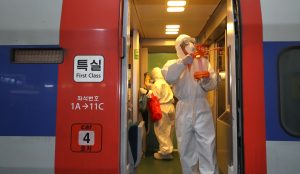Heralded as a model for containing COVID-19 as the disease rapidly spread around the world last year, South Korea now finds itself struggling to stem the virus at home. Responding to the climbing caseload, the government has raised social distancing measures to their highest level in the greater Seoul area for two weeks as of Monday. Though these restrictions fall short of a full lockdown to keep the economy humming, if the surge in new infections is not brought under control soon it could slow an otherwise promising recovery and necessitate additional stimulus.
Much as it has been in other parts of the world, the Delta variant is behind the spike in new cases in South Korea. The seven-day average of daily new cases climbed to nearly 1,200 at the start of this week, almost doubling the figure from July 1. The country had been making steady progress in distributing vaccines, with the percentage of the population having received at least one dose increasing from 7.6 percent on May 25 to 29.1 percent by June 19, yet this has since plateaued. While new cases remain relatively low – as of July 15, the daily new cases per million people is under half the world average – and South Korea recently signed a deal with Israel to get access to 700,000 vaccines in the near future, the government was still compelled to take additional action.
The newest social distancing measures in the capital region, where the virus is spreading most quickly, are the strictest since those implemented in Daegu at the height of South Korea’s first outbreak in March last year. Under the new rules, private gatherings of up to four people are allowed during the day but after 6 p.m. this goes to down to two people. All rallies and protests are temporarily banned; major sporting events will not have in-person spectators; and religious events will be virtual. Nightclubs, bars, and other similar facilities will be closed but gyms, hotels, movie theaters, concert halls, restaurants and cafes, and retail stores will all be open with certain new restrictions. Other than companies in manufacturing, businesses have been encouraged to allow 30 percent of staff to work from home and stagger commute and work schedules.
Although these new public health actions are intended to minimize drag on the domestic economy, they are likely to pose challenges – particularly to small-and medium sized enterprises (SMEs). Many large family-run South Korean conglomerates known as chaebol have shifted their own policies in parallel to these new changes, including a greater reliance on telework and suspending business trips, but other industries that are more dependent on face-to-face interaction such as the service sector will find making their own adjustments to be more difficult. The effects are also much more likely to be felt in smaller companies, which by all accounts are already struggling. A report by the Bank of Korea last month highlighted that the 14.1 percent increase in corporate loans at the end of the first quarter this year compared to the same period in 2020 was driven by SMEs looking to cover operating costs even as large enterprises increasingly opted for raising funds from financial markets instead.
The measures are also coming just as at the domestic economy is picking up steam. South Korean GDP in the first quarter rose 1.8 year-over-year, in part buttressed by rising consumer spending at home. Compared to the last quarter of 2020, during the previous spike in coronavirus cases, consumption in the first three months of the year grew by 1.3 percent – the highest quarterly growth since April-June 2020 when the number of new cases rarely exceeded 50 in a day.
Even so, South Korea’s overall economic recovery from the pandemic continues to be closely tied to exports and chaebols. South Korea’s economy shrank less than any other OECD economy in 2020; the key reason was a strong export performance in the second half of the year. While export growth has slowed this year so far, investment in new productive facilities has picked up the pace. Both indicators are strongly linked with chaebols. South Korean conglomerates produce top export items such as semiconductors, autos, petrochemicals, and ships. Much of the new investment can be attributed to efforts to further develop the export capacity of these companies, such as spending by Samsung Electronics and SK Hynix to build new semiconductor plants.
Still, there is only so much that can be expected from overseas demand to help buoy the South Korean economy amid rising caseloads. A dual track recovery for SMEs and conglomerates, which despite their outsized economic importance only account for 12 percent of those employed, would worsen South Korea’s income inequality problem. Additionally, if the virus continues at its current rate of transmission, it could result in at least temporary slowdowns in manufacturing goods intended to be sent overseas, similar to what happened to Hyundai, Samsung, and LG last year. As resilient as South Korean exports have proven so far, disruptions to demand are also conceivable as the Delta variant spreads elsewhere.
At the end of the day, two weeks of heightened social distancing to rein in new cases is far from being the proverbial straw to break the back of the South Korean economy. Yet, if the virus continues to spread unchecked and more stringent, drawn-out containment measures are needed before vaccines can be more widely distributed, it could dampen the outlook for growth in the near future and prompt more stimulus than the government had previously planned.

































